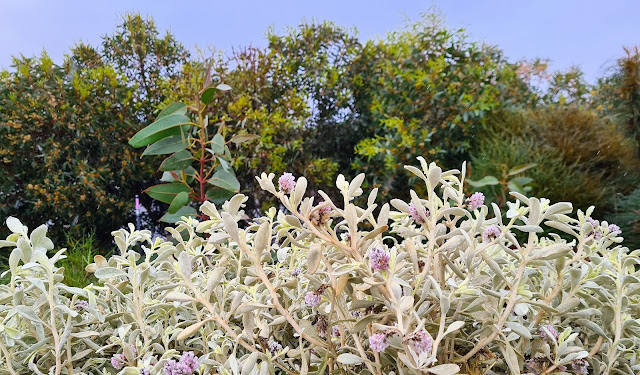Cotton Bush has tail wanting
Ptilotus are commonly called Fox, Pussy, Hairy, Rabbit or Lamb Tails, on account of the often feathery, clearly tail-like, terminal clusters of flowers. Or sometimes the name Mulla Mulla, from an (unknown) First Nations language in the west is used.
The leaves and stems of Ptilotus are mostly (but not always) 'softly' hairy, but Ptilotus obovatus is particularly woolly and greyish white. The flowers too can be partly obscured by white tufty hairs, but don't form the elegant 'tails' of many other species.
Like most species, though, Cotton Bush grows in Western Australia. In this case it also extends through inland South Australia and Northern Territory across into eastern Australia - to New South Wales, Queensland and, barely, Victoria.
In Victoria it is known only from a few places in the far north-west corner of the State, and then only in recent decades. Before that we had only a couple of pre-1900 herbarium records and assumed it had become extinct (or been mislabelled - the locations were vague regional names).
In South Australia, where this species is particularly common and widespread, there are lots of local names for the Cotton Bush, including: Silver Mulla Mulla, Silver-tails, Smoke Bush (a name more commonly applied to Conospermum, in the Proteaceae family), Silver Bush, White Fox Tail, Flannel Flower (and name more commonly applied to Actinotus in the Apiaceae - carrot - family) and Goldfield Clover. Most of these reference the colour and texture of the leaves, with a passing nod to the (stumpy) flowering spikes.
Ptilotus is in the plant family Amaranthaceae, which includes spinach, beet and quinoa, along with some garden favourites such as the namesake Amaranthus. The flowers of other genera in this family are often arranged in spikes, sometimes resembling those on the more elegant species of Ptilotus.
Less than a third of Pilotus species are found in Eastern Australia, and Cotton Bush itself was first described from a plant growing near Shark Bay in Western Australia. Across its range it grows in many habitats, from clay plains to rocky hillsides. The plants I photographed in the Australian Garden are freshly planted on Howson Hill, in what we hope is now well drained but well-watered sand.
Note: This was such fun, I'll return to weekly as I head towards my final days at Royal Botanic Gardens Victoria (finishing 3 August 2023). After that, all bets are off!





Comments